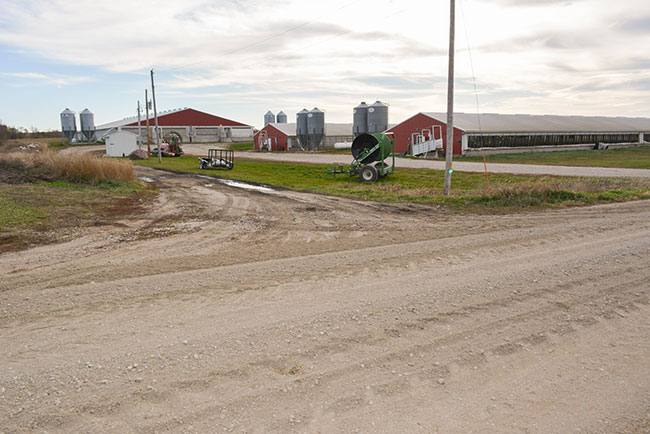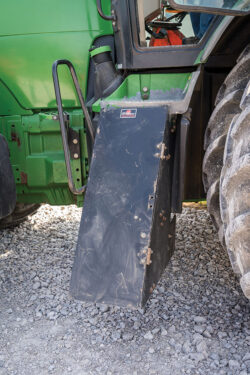
Features
Safe and (bio)secure
Minimizing biosecurity risks from manure.
January 16, 2024 by James Careless
 A two-drive site. Farm workers use a primary driveway, while a secondary drive is primarily used for manure application equipment to help with the lines of separation.
CREDITS: Images courtesy of Dan Andersen
A two-drive site. Farm workers use a primary driveway, while a secondary drive is primarily used for manure application equipment to help with the lines of separation.
CREDITS: Images courtesy of Dan Andersen By its very nature of being animal waste, manure is a natural repository for disease. Some of the diseases can be ‘zoonotic’; in other words, capable of being passed from animals to humans via exposure to infected manure. The list of zoonotic diseases include anthrax, brucellosis, cryptosporidiosis, dermatophilosis, Escherichia coli, giardiasis, leptospirosis, listeriosis, pseudocowpox, Q fever, rabies, ringworm, salmonellosis, tuberculosis, and vesicular stomatitis.
“There are a number of pathogens shed in livestock manure that can be harmful to human health,” says Amy Millmier Schmidt, professor of biological engineering at University of Nebraska-Lincoln. “These are considered zoonotic diseases since they can spread among different species.”
In contrast, diseases like “African Swine Fever, HPAI, foot and mouth disease, PEDV and many other diseases of livestock and poultry are dangerous to the health of animals within that particular species,” she observes. “But these do not pose a direct threat to human health.”
This said, diseases that can only be spread from animal to animal via infected manure are just as serious. Left unchecked, they can kill vast numbers of livestock and lead to severe financial losses for farmers.
A prime example is Johne’s disease, a contagious, chronic, and usually fatal infection of ruminants’ small intestines that is passed on by the ingestion of infected manure — such as when a calf nurses on a mother’s udder with manure traces on it. “Any disease-causing organisms excreted in manure from livestock (e.g. enteric diseases) are able to be transmitted to other animals through fecal-oral routes,” says Schmidt.
So how serious a problem is Johne’s disease, which results in reduced milk production in dairy cattle and short productive lifespans? According to the U.S. Department of Agriculture’s Animal and Plant Health Inspection Service, “about 68 percent of U.S. dairy herds have at least one cow that tests positive for Johne’s with herd prevalence approaching 100 percent in large dairy herds. Because few herds have instituted biosecurity programs, infection continues to spread. Although infection seems less widely distributed in beef and goat herds and sheep flocks, Johne’s is nonetheless of critical significance to all producers.”
The key word here is ‘biosecurity’. To minimize the transmission of disease from manure to animals and humans alike — and the serious consequences from this happening — farmers, animal producers, and manure haulers need to treat this substance as the biohazard it is. For this to happen, they must adopt safe handling practices for farm animal manure. By implementing proper ‘biosecurity’ measures and management practices, the risks associated with disease transfer can be significantly reduced.
Understanding the enemy
To understand what it takes to establish effective, viable biosecurity to minimize disease transmission via manure, one needs to know how this enemy of animal and human health operates first.
For example, “contaminated manure may infect humans via direct exposure through the handling or processing of manure,” says Daniel Andersen, associate professor and extension specialist at Iowa State University. “But some zoonotic diseases include HPAI, ASF, and Hep E. In manure the disease needs a fecal-oral mode of transmission. Some diseases can be spread in aerosolized form — such as swine influenza, which is spread by sneezing. Other diseases we deal with in the swine industry include Porcine epidemic diarrhea (PED) and Porcine Reproductive and Respiratory Syndrome (PRRS). While these aren’t zoonotic, their transmission is extremely important to manage and control.”
Then there are ‘vectors’ that spread disease from manure. According to the European Food Safety Authority, “A vector is a living organism that transmits an infectious agent from an infected animal to a human or another animal.”
When it comes to spreading disease from manure, “people, fomites, insects, wild animals, and air” are the main vectors, says Anderson. “People entering the facility are the largest risk.”
The specific ‘vectors of transmission’ from humans include “boots and clothing worn from a production area/building into another without thorough cleaning and disinfection,” says Schmidt. Other vectors can include “hands or tools that are not washed/disinfected properly between contact with sick and healthy animals, vehicles that are not thoroughly cleaned and disinfected after being used to transport employees or animals, and even domestic pets or pests.”
Then there are fomites, which are “any object or material that is likely to carry an infection agent,” explains Robb Meinen, assistant research professor with the Penn State department of plant science. “Anytime you handle manure you are handling a high-risk fomite.”
There is one other vector that often goes unseen, which “moves from farm to farm,” says Courtney Wilson, compliance specialist with the Georgia Department of Agriculture. These are “Rodents!” she declares – rats, mice, and any other kind of rodent that use poorly-kept barns as all-they-can-eat buffets. “Clean up your feed areas so that you don’t attract rodents that are looking for food,” says Wilson. “They do travel and will travel [far] to find food.”
Biosecurity best practices for limiting disease transmission
In all of the instances listed above, biosecurity-minded steps can and should be taken to block these routes of infection transmission via manure.
The first best practice comes down to minimizing exposure to manure by humans and animals. Their holding areas should be built to minimize retention of manure as much as possible, and any manure that remains should be removed immediately. Adhering to the old stereotype of ‘shoveling out the sh*t at the end of the day’ is a sure way to spread disease.
Human operators should also wear protective clothing when handling manure. Coveralls, boots, gloves, masks, and eyewear are good ways of minimizing their ingestion of manure particles.
Once manure has been removed, it needs to be stored away from animals, humans, and weather sources in safe, contained areas. It is vital to ensure that these manure storage facilities are well-maintained, properly sealed, and equipped with appropriate ventilation systems to reduce the risk of airborne pathogens. Just dumping it on a pile on the ‘back 40’ is no solution.

A step cover used by an Iowa manure applicator which helps make tractor steps easier to clean and potentially curbs the spread of disease as people mount on and off the tractor.
Of course, manure doesn’t magically remove itself. It requires human-operated tools and machines to move it from the barn to the storage area. This is why regular cleaning and disinfection of equipment used for handling manure is a Biosecurity Best Practice. Equipment such as shovels, buckets, or pumps should be cleaned thoroughly after every contact with manure to remove any potential pathogens. Disinfectants approved for agricultural applications should be also used according to manufacturer instructions — after assessing any harmful side effects on livestock, humans, and runoff into the soil.
This brings us best practices for reducing the vectors of transmission. When it comes to people, “a minimum precaution is washing boots before and after a farm visit, all the way to ‘shower in/shower out’ and wearing only farm clothes that stay at the facility,” says Anderson. “And depending on the livestock species, there should be a different biosecurity protocol for each.”
“All equipment, clothing, and people working with manure are at high risk,” notes Meinen. “Biosecurity standards are the best defense that we have to minimize disease transfer risk.”
Then there are the other fomites, namely anything that comes into contact that can retain infectious agents after exposure. This applies during the removal of manure onsite, and the transportation of it away from animal holding areas afterwards. Without exception, “equipment that touches manure needs to be treated as contaminated,” says Andersen. “Manure application equipment that goes onsite needs to have the mud and manure washed off before arriving.”
As well, “arrange traffic flow at the site so that lines of separation between those people working on the manure removal and those caring for the animals can be maintained,” he said. “Good hygiene goes a long way as well: If you spill some manure, clean it up as best as possible to avoid tracking around and limit the risk of other people inadvertently touching and becoming a biosecurity risk.”
Remember: “Manure handling equipment — agitators, pumps, hoses, application equipment — can carry disease-causing organisms from a ‘dirty’ site to a ‘clean’ site if they aren’t properly washed to remove all organic residue and followed by a disinfectant used according to industry recommendations,” says Schmidt. People performing manure handling activities can also serve as vectors for disease transmission if they don’t take similar steps to prevent the spread of disease due to manure contamination.
By “not cleaning and disinfecting their equipment between farms” contagion can be spread by haulers,” explains Wilson. They “need to ensure that they are following biosecurity protocols when changing from one farm to another under different ownership.”
Here’s another practice to consider: Devising and then following a strict manure management plan can reduce disease transmission risks. Besides the points mentioned above, proper composting techniques for manure storage ensures the piles get hot enough for pathogen destruction. And after all, composting reduces disease-causing organisms while converting manure into valuable fertilizers.
Close collaboration between animal producers, haulers, veterinarians, and public health officials is vital for ensuring that effective disease prevention strategies are in place and working on a continuing basis. Regular training sessions on biosecurity measures can also help educate individuals involved in handling farm animal manure about best practices for preventing disease transmission.
Granted, it takes time and money to implement biosecurity best practices for safe manure handling. But the payoffs are real and well worth the effort. Safe manure handling leads to healthier livestock, better financial returns (and reduced veterinary costs), and a reduction in zoonotic disease infections — which is particularly important as expanding urban communities encroach on livestock farms and feedlots.
The bottom line: “Good standard operating procedures assume that the unseen bacteria or virus is always present,” says Meinen. “The manure handler should want to take themselves out of the disease transfer equation by minimizing risk.” This is why “the practical solution is to adhere to strict biosecurity standards.” •